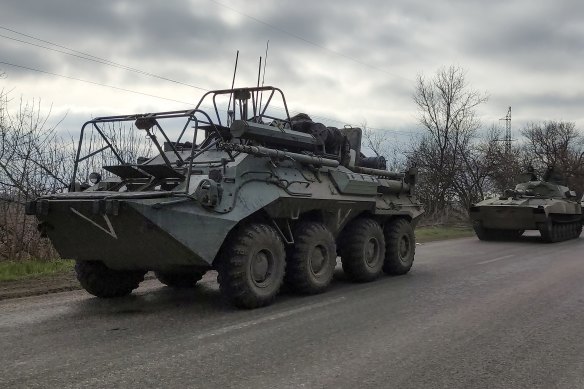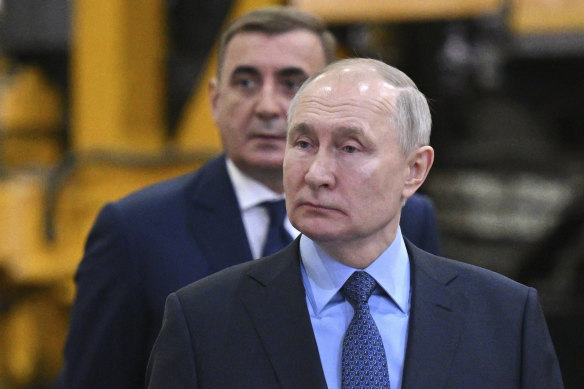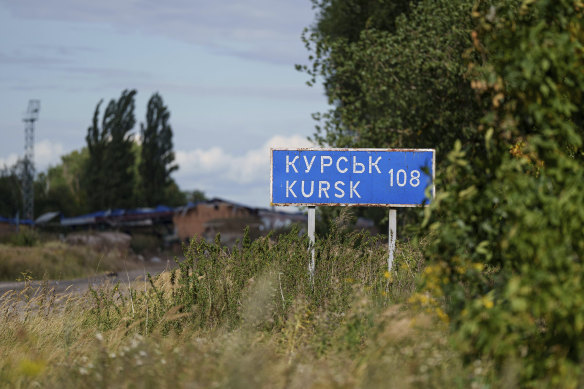This was published 3 months ago
Putin pulls back troops from Ukraine to resist Kursk invasion
Russia has withdrawn some troops from Ukraine to help reinforce the invasion of Russia near Kursk, US and Ukrainian officials say.
Ukraine said on Tuesday that its biggest cross-border assault of the war to date had taken control of 74 settlements in Russia’s region of Kursk and was still advancing, making gains of one to three kilometres in the past 24 hours.

A Russian military convoy near Mariupol on Saturday. Mariupol, a strategic port on the Sea of Azov, has been resisting Russian troops for almost seven weeks.Credit: AP
“Russia has relocated some of its units from both Zaporizhzhia and Kherson regions of Ukraine’s south,” Ukrainian army spokesman Dmytro Lykhoviy told Politico.
US officials also told the Wall Street Journal that Russia had repositioned troops after Ukraine’s mini-invasion.
However, they wouldn’t say how many troops had moved and how significant the shift might be, the WSJ reported.
Ukraine blindsided Moscow by pouring thousands of troops into the western Russian region of Kursk last week. The surprise operation has given Ukraine its biggest battlefield gains since 2022 after months on the back foot.

Russian President Vladimir Putin has vowed to hit back at Ukraine.Credit: AP
Kyiv’s account jarred with the picture painted by Russia, where Major General Apti Alaudinov said Ukraine’s troops had been halted, while the defence ministry said attacks had been repelled at villages about 26 to 28 kilometres from the border.
Ukraine President Volodymyr Zelensky said Kyiv’s forces had rounded up Russian prisoners of war who could be swapped for captured Ukrainian fighters, touting what he described as an expanding “exchange fund”.
“Despite difficult and intense battles, our forces continue to advance in the Kursk region, and our state’s ‘exchange fund’ is growing. Seventy-four settlements are under Ukrainian control,” Zelensky said.
As shown in the video link, the Ukrainian leader asked his top commander, Oleksandr Syrskyi, to develop the next “key steps” in the operation.

A sign indicating 108 kilometres to Kursk on the Russian-Ukrainian border in Sumy region, Ukraine.Credit: AP
“Everything is being executed according to the plan,” Syrskyi replied, without elaborating.
Kyiv has disclosed few details about its plans, in stark contrast with last year’s counteroffensive that was vaunted months in advance – before failing to breach well-prepared Russian defensive lines.
A week after the start of the shock offensive, Kursk regional governor Alexei Smirnov called on residents to show patience and character.
“I’ll say it straight: the crisis has not yet been overcome,” he wrote on social media.
Russian President Vladimir Putin has vowed to hit back at Ukraine with a “worthy response” and accused Kyiv’s “Western masters” of helping Ukraine.
At the United Nations, Russia called out Kyiv’s allies for not condemning the incursion.
US President Joe Biden, in his first substantive comments, said Washington was in constant contact with Kyiv about the operation, although the White House said earlier it was not engaged in any aspect of planning or preparation.
“It’s creating a real dilemma for Putin,” Biden said.
Ukraine has cast the operation as defensive, saying its troops have taken control of areas that Russia has used to launch more than 2000 cross-border strikes since June.
“Ukraine is not interested in taking the territory of the Kursk region, but we want to protect the lives of our people,” said the foreign ministry’s spokesman Heorhii Tykhyi.
Russian forces have been trying to advance for months on multiple fronts in the eastern Donetsk region, taking advantage of their greater troop numbers to inch towards cities like the Kyiv-held logistics hub of Pokrovsk.
Tykhyi said: “It should be emphasised that the (Kursk) operation ... helps the front line because it does not allow Russia to transfer additional units to the Donetsk region, complicates its military logistics.”
For now, there is no sign of a let-up for Ukraine in the east, where Kyiv’s military said earlier it had recorded the largest number of battles with Russian forces on the Pokrovsk front in a single day since before the Kursk incursion.
On a trip to Kyiv on Tuesday, Lithuanian Defence Minister Laurynas Kasciunas said Russia was moving troops from its Baltic exclave of Kaliningrad to reinforce Kursk.
Pasi Paroinen, an analyst with the Black Bird Group, said on Monday that Russia had mostly relied on nearby military units to try to push back Ukrainian forces.
“Russians should have enough reserves, so that they should not be forced to weaken the ‘centre’ group of forces, which is currently pressuring the Ukrainian lines near Toretsk and Pokrovsk,” he said.
Reuters
Get a note directly from our foreign correspondents on what’s making headlines around the world. Sign up for the weekly What in the World newsletter here.